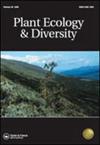Changes in liana community structure and functional traits along a chronosequence of selective logging in a moist semi-deciduous forest in Ghana
IF 1.6
4区 生物学
Q2 PLANT SCIENCES
引用次数: 7
Abstract
ABSTRACT Background: Lianas are an important component of tropical forests that respond to logging disturbance. Determining liana response to selective logging chronosequence is important for understanding long-term logging effects on lianas and tropical forests. Aims: Our objective was to quantify the response of liana communities to selective logging chronosequence in a moist semi-deciduous forest in Ghana. Methods: Liana community characteristics were determined in ten 40 m × 40 m plots randomly and homogenously distributed in each of four selectively logged forest stands that had been logged 2, 14, 40 and 68 years before the surveys and in an old-growth forest stand (ca. >200 years). Results: Liana species composition differed significantly among the forest stands, as a function of logging time span, while species richness fluctuated along the chronosequence. The abundance of liana communities and of reproductive and climbing guilds was lower in the logged forests than in the old-growth forest. The ratio of liana abundance and basal area to those of trees was similar in the logged forests, but significantly lower than those in the old-growth forest. Conclusions: Logging impacts on liana community structure and functional traits were largely evident, though no clear chronosequence trends were recorded, except for species composition.加纳湿润半落叶林藤本植物群落结构和功能特征随选择性采伐时序的变化
摘要背景:藤本植物是热带森林的一个重要组成部分,对伐木干扰具有响应作用。确定藤本植物对选择性伐木时序的反应对于理解长期伐木对藤本植物和热带森林的影响很重要。目的:我们的目标是量化加纳潮湿半落叶林中藤本植物群落对选择性采伐时序的反应。方法:在调查前2年、14年、40年和68年被选择性砍伐的4个林分中的每一个林分和一个老林分(约>200年)中随机均匀分布的10个40 m×40 m的样地中测定莲属群落特征。结果:不同林分藤本植物的物种组成存在显著差异,是伐木时间跨度的函数,而物种丰富度则随时间序列而波动。砍伐森林中藤本植物群落以及繁殖和攀爬群落的丰度低于老森林。砍伐森林中藤本植物的丰度和基底面积与树木的比值相似,但明显低于老林。结论:采伐对藤本植物群落结构和功能性状的影响非常明显,但除物种组成外,没有记录到明确的时序趋势。
本文章由计算机程序翻译,如有差异,请以英文原文为准。
求助全文
约1分钟内获得全文
求助全文
来源期刊

Plant Ecology & Diversity
PLANT SCIENCES-
CiteScore
3.30
自引率
0.00%
发文量
26
审稿时长
3 months
期刊介绍:
Plant Ecology and Diversity is an international journal for communicating results and novel ideas in plant science, in print and on-line, six times a year. All areas of plant biology relating to ecology, evolution and diversity are of interest, including those which explicitly deal with today''s highly topical themes, such as biodiversity, conservation and global change. We consider submissions that address fundamental questions which are pertinent to contemporary plant science. Articles concerning extreme environments world-wide are particularly welcome.
Plant Ecology and Diversity considers for publication original research articles, short communications, reviews, and scientific correspondence that explore thought-provoking ideas.
To aid redressing ‘publication bias’ the journal is unique in reporting, in the form of short communications, ‘negative results’ and ‘repeat experiments’ that test ecological theories experimentally, in theoretically flawless and methodologically sound papers. Research reviews and method papers, are also encouraged.
Plant Ecology & Diversity publishes high-quality and topical research that demonstrates solid scholarship. As such, the journal does not publish purely descriptive papers. Submissions are required to focus on research topics that are broad in their scope and thus provide new insights and contribute to theory. The original research should address clear hypotheses that test theory or questions and offer new insights on topics of interest to an international readership.
 求助内容:
求助内容: 应助结果提醒方式:
应助结果提醒方式:


